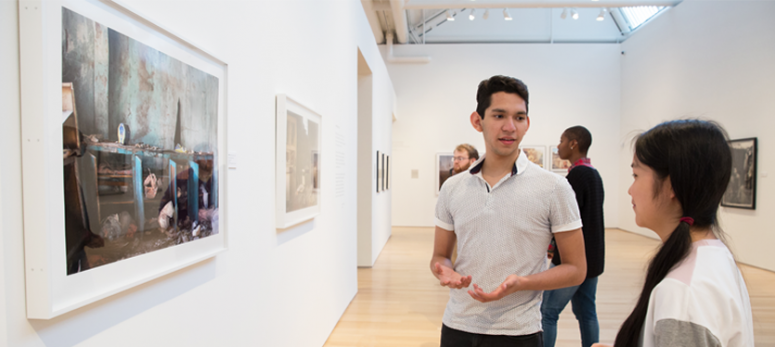Art of the Aftermath

From Kenyon News - March 20, 2017
Too often, the American public’s view of foreign war begins and ends at the front line — if the conflict even manages to capture widespread attention in the first place. The Gund Gallery’s exhibition “Aftermath: The Fallout of War,” on view through April 20, seeks to remedy this issue by focusing on the stories that emerge once the fighting is finished.
“When there’s a war, all you hear about is the war, and the breaking news, and the drama of it,” said Rania Matar, a Lebanese American photographer who is one of a dozen artists featured in the exhibition. “When it’s over, people move on to the next story.”
Several of Matar’s photographs in the series “What Remains” focus on the remnants of “people’s lives that were scattered on the floor” following the 2006 Lebanon War: a wedding album amid charred papers or a crushed tin of cookies buried beneath rubble. Her more recent series, “Invisible Children,” points a lens at young Syrian refugees whom Matar met on the streets of Beirut.
Of the 12 artists featured in “Aftermath,” nine are women, and several, including Matar, are from the Middle East. Their techniques and styles, however, vary widely. American photographer Ben Lowy documented revolution in Libya using only an iPhone. Photojournalist Simon Norfolk juxtaposed colonial-era photographs taken during the Second Anglo-Afghan War (1878-80) with photos he took in Afghanistan in 2010-11. Jennifer Karady depicted American soldiers reliving traumatic experiences in their home environments, in uniform but surrounded by family members. Suzanne Opton asked American soldiers who were returning for another tour to rest their heads on a table and stare into her camera, their expressive eyes providing an intimate look at the people behind the uniform.
Through these photographs, curator Carol McCusker aimed to open viewers’ eyes to the depth of humanity in the Middle East. “Most Americans live in a kind of distant awareness or outright ignorance about the exact nature of the strife visited on people in this particular time in history,” she said. “These photographs put a face on the crisis, to show the particulars of life in wartime. The hope [is] to generate empathy for human beings, no matter where they live.”
Gund Gallery audiences are able to engage with “Aftermath” beyond viewing the exhibition. In one room, a chalkboard invites visitors to answer questions like, “If you were a photographer in these areas, how would you get to know those around you?” The gallery also has scheduled film screenings, faculty talks and children’s storytime events that correspond to the exhibition’s themes.
“We really wanted to present an exhibition on these timely themes, and it’s hard to find or organize just the right exhibition that’s balanced and also respectful,” said Gund Gallery Director Natalie Marsh. “We were fortunate to hear from colleagues at the Harn Museum at the University of Florida about this project and jumped at the chance to host it on its short national tour.” While the gallery hasn’t been afraid to tackle tough and political subjects in the past, Marsh acknowledges that “Aftermath” is a particularly difficult show for some viewers. “It’s a pretty moving exhibition,” she said. “We’ve heard a lot of feedback from faculty members, students and community members who feel like they have to come back more than once in order to take it in.”
Questions presented by the exhibition are being asked in the classroom as well. Matar, who is in the midst of a residency at Kenyon, has visited courses in multiple departments, finding something about her work to touch on in each discipline. The focus of her residency is centered on a collaboration with a “Clinical Psychology” course taught by Associate Professor of Psychology Irene Lopez. Matar explained that working as a photographer in war-torn communities requires an understanding of psychology. “How do you observe people, how do you gain their trust, how do you not cross the boundaries of what’s ethical and what’s not?”
“Aftermath” also highlights the moments of hope that can emerge from the fallout of war. At the front of the gallery, one of the first photographs viewers see is one of Matar’s. As a bombed-out building is demolished behind them, a mother looks on, smiling, as her young daughter gazes away from the destruction. “It was about hope, in some way, and about resilience and about humanity,” Matar said. “She’s almost like a phoenix rising out of the ashes.”